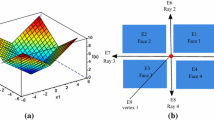Abstract
We present a new algorithm to compute the Legendre–Fenchel conjugate of convex piecewise linear-quadratic (PLQ) bivariate functions. The algorithm stores a function using a (primal) planar arrangement. It then computes the (dual) arrangement associated with the conjugate by looping through vertices, edges, and faces in the primal arrangement and building associated dual vertices, edges, and faces. Using optimal computational geometry data structures, the algorithm has a linear time worst-case complexity. We present the algorithm, and illustrate it with numerical examples. We proceed to build a toolbox for convex bivariate PLQ functions by implementing the addition, and scalar multiplication operations. Finally, we compose these operators to compute classical convex analysis operators such as the Moreau envelope, and the proximal average.












Similar content being viewed by others
References
Bauschke, H.H., Goebel, R., Lucet, Y., Wang, X.: The proximal average: basic theory. SIAM J. Optim. 19(2), 768–785 (2008). doi:10.1137/070687542
Bauschke, H.H., Lucet, Y., Trienis, M.: How to transform one convex function continuously into another. SIAM Rev. 50(1), 115–132 (2008). URL: http://link.aip.org/link/?SIR/50/115/1
Bauschke, H.H., Lucet, Y., Wang, X.: Primal-dual symmetric intrinsic methods for finding antiderivatives of cyclically monotone operators. SIAM J. Control Optim. 46(6), 2031–2051 (2007). URL: http://link.aip.org/link/?SJC/46/2031/1
Bauschke, H.H., Matoušková, E., Reich, S.: Projection and proximal point methods: Convergence results and counterexamples. Nonlinear Anal. 56(5), 715–738 (2004). doi:10.1016/j.na.2003.10.010
Bauschke, H.H., Moffat, S.M., Wang, X.: Self-dual smooth approximations of convex functions via the proximal average. In: Bauschke, H.H., Burachik, R.S., Combettes, P.L., Elser, V., Luke, D.R., Wolkowicz, H. (eds.) Fixed-Point Algorithms for Inverse Problems in Science and Engineering, Springer Optimization and Its Applications, vol. 49, pp. 23–32. Springer, New York (2011). doi:10.1007/978-1-4419-9569-8_2
Bauschke, H.H., Mohrenschildt, M.V.: Symbolic computation of Fenchel conjugates. ACM Commun. Comput. Algebra 40(1), 18–28 (2006). doi:10.1145/1151446.1151453
Borwein, J.M., Hamilton, C.H.: Symbolic Fenchel conjugation. Math. Program. 116(1), 17–35 (2008). doi:10.1007/s10107-007-0134-4
Botelho, F.C., Lacerda, A., Menezes, G.V., Ziviani, N.: Minimal perfect hashing: a competitive method for indexing internal memory. Inf. Sci. 181(13), 2608–2625 (2011). URL: http://www.sciencedirect.com/science/article/pii/S0020025509005271
Brenier, Y.: Un algorithme rapide pour le calcul de transformées de Legendre-Fenchel discrètes. C. R. Acad. Sci. Paris Sér. I Math. 308, 587–589 (1989)
CGAL, Computational Geometry Algorithms Library. URL: http://www.cgal.org
CGLAB a Scilab toolbox for geometry based on CGAL. URL: http://cglab.gforge.inria.fr/
Corrias, L.: Fast Legendre-Fenchel transform and applications to Hamilton-Jacobi equations and conservation laws. SIAM J. Numer. Anal. 33(4), 1534–1558 (1996). URL: http://www.jstor.org/stable/2158316
Czech, Z.J., Havas, G., Majewski, B.S.: Perfect hashing. Theor. Comput. Sci. 182(1–2), 1–143 (1997). URL: http://www.sciencedirect.com/science/article/pii/S0304397596001466
de Berg, M., van Kreveld, M., Overmars, M., Schwarzkopf, O.: Computational Geometry, 3rd edn. Springer, Berlin (2008). URL: http://www.springer.com/computer/theoretical+computer+science/book/978-3-540-77973-5. Algorithms and applications
Gardiner, B., Lucet, Y.: Convex hull algorithms for piecewise linear-quadratic functions in computational convex analysis. Set-Valued Var. Anal. 18(3–4), 467–482 (2010). doi:10.1007/s11228-010-0157-5
Gardiner, B., Lucet, Y.: Graph-matrix calculus for computational convex analysis. In: Bauschke, H.H., Burachik, R.S., Combettes, P.L., Elser, V., Luke, D.R., Wolkowicz, H. (eds.) Fixed-Point Algorithms for Inverse Problems in Science and Engineering, Springer Optimization and Its Applications, vol. 49, pp. 243–259. Springer, New York (2011). doi:10.1007/978-1-4419-9569-8_12
Goebel, R.: Self-dual smoothing of convex and saddle functions. J. Convex Anal. 15(1), 179–190 (2008). URL: http://www.heldermann.de/JCA/JCA15/JCA151/jca15012.htm
Goodrich, M.T., Tamassia, R.: Data Structures and Algorithms in Java, 5th edn. Wiley, New York (2010)
Hiriart-Urruty, J.B., Lemaréchal, C.: Convex Analysis and Minimization Algorithms, Grundlehren der Mathematischen Wissenschaften [Fundamental Principles of Mathematical Sciences], vol. 305–306. Springer, Berlin (1993). URL: http://www.springer.com/math/book/978-3-540-56850-6. Vol I: Fundamentals, Vol II: Advanced theory and bundle methods
Johnstone, J., Koch, V., Lucet, Y.: Convexity of the proximal average. J. Optim. Theory Appl. 148, 107–124 (2011). doi:10.1007/s10957-010-9747-5
Lucet, Y.: A fast computational algorithm for the Legendre-Fenchel transform. Comput. Optim. Appl. 6(1), 27–57 (1996). URL: http://www.springerlink.com/content/x777265871618672/
Lucet, Y.: Computational Convex Analysis Library (1996–2011). URL: https://people.ok.ubc.ca/ylucet/cca.html
Lucet, Y.: Faster than the Fast Legendre Transform, the Linear-time Legendre Transform. Numer. Algorithms 16(2), 171–185 (1997). URL: http://www.springerlink.com/content/m41t352758814q50/
Lucet, Y.: A linear Euclidean distance transform algorithm based on the Linear-time Legendre Transform. In: Proceedings of the Second Canadian Conference on Computer and Robot Vision (CRV 2005), pp. 262–267. IEEE Computer Society Press, Victoria BC (2005)
Lucet, Y.: Fast Moreau envelope computation I: numerical algorithms. Numer. Algorithms 43(3), 235–249 (2006). doi:10.1007/s11075-006-9056-0. URL: http://www.springerlink.com/content/h80k45x24t1q7426/
Lucet, Y.: What shape is your conjugate? A survey of computational convex analysis and its applications. SIAM Rev. 52(3), 505–542 (2010). doi:10.1137/100788458
Lucet, Y., Bauschke, H.H., Trienis, M.: The piecewise linear-quadratic model for computational convex analysis. Comput. Optim. Appl. 43, 95–118 (2009). URL: http://www.springerlink.com/content/j726881521t4541l/
Moffat, S.M.: On the Kernel Average of n Functions. Master’s thesis, Department of Mathematics, University of British Columbia (2009). URL: http://hdl.handle.net/2429/21932
Moreau, J.J.: Proximité et dualité dans un espace Hilbertien. Bull. Soc. Math. France 93, 273–299 (1965). URL: http://www.numdam.org/item?id=BSMF_1965__93__273_0
Noullez, A., Vergassola, M.: A fast Legendre transform algorithm and applications to the adhesion model. J. Sci. Comput. 9(3), 259–281 (1994). URL: http://www.springerlink.com/content/h8733538m6523g82
Rockafellar, R.T., Wets, R.J.B.: Variational Analysis. Springer, Berlin (1998). URL: http://www.springer.com/math/book/978-3-540-62772-2
Scilab Consortium: Scilab (1994). URL: http://www.scilab.org
She, Z.S., Aurell, E., Frisch, U.: The inviscid Burgers equation with initial data of Brownian type. Commun. Math. Phys. 148(3), 623–641 (1992). URL: http://projecteuclid.org/euclid.cmp/1104251047
Sun, J.: On the structure of convex piecewise quadratic functions. J. Optim. Theory Appl. 72(3), 499–510 (1992). doi:10.1007/BF00939839
Author information
Authors and Affiliations
Corresponding author
Additional information
Yves Lucet was partially supported by a Discovery grant from the Natural Sciences and Engineering Research Council of Canada (NSERC). Bryan Gardiner was partially supported by an NSERC Undergraduate Student Research Award. Part of the research was done in the Computer-Aided Convex Analysis laboratory funded by the Canadian Foundation for Innovation under a Leaders Opportunity Fund.
Rights and permissions
About this article
Cite this article
Gardiner, B., Lucet, Y. Computing the conjugate of convex piecewise linear-quadratic bivariate functions. Math. Program. 139, 161–184 (2013). https://doi.org/10.1007/s10107-013-0666-8
Received:
Accepted:
Published:
Issue Date:
DOI: https://doi.org/10.1007/s10107-013-0666-8
Keywords
- Computer-aided convex analysis
- Computational convex analysis
- Fenchel conjugate
- Legendre–Fenchel transform
- Convex subdifferential
- Planar arrangement




